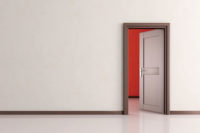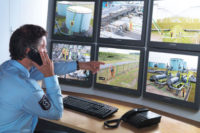The Forgotten and Oft-Neglected Door Closer
Primarily associated with fire code compliance in typical applications, the door closer not only assists in reducing the spread of fire within a building. It assists us with physical security, user convenience and compliance and HVAC management. The door closer has a myriad of uses in electronic card access applications in creative and very functional applications. They also reduce our common nemesis, another potential nuisance alarm – a door held or propped open.
A card access equipped door is typically a door system that includes a door closer or operator. The mechanical door closer may not be chosen with the same attention to detail that other access control components are regarded. In card access, they may often be installed on indoor, non fire rated doors. This can be relatively new territory for the use of mechanical door closers depending upon your facility. These abused, oft forgotten devices have been around since the late 1800s and are one of our best tools to securing spaces regardless of the locking method. At virtually any building, campus of many buildings, corporate headquarters, remote sites, etc., there likely is someone on staff who has been specifying the same trusty brand and model of closer throughout their career, with some variations. There are good reasons for this, such as parts inventory, staff familiarity with adjusting and installing them. So, for the typical application, if the devices are not failing regularly, are doing their job and aren’t knocking over entering occupants and spraying them with oil, there is no compelling reason to change standards. But what about locations where things aren’t going so well?
A card access equipped door is typically a door system that includes a door closer or operator. The mechanical door closer may not be chosen with the same attention to detail that other access control components are regarded. In card access, they may often be installed on indoor, non fire rated doors. This can be relatively new territory for the use of mechanical door closers depending upon your facility. These abused, oft forgotten devices have been around since the late 1800s and are one of our best tools to securing spaces regardless of the locking method. At virtually any building, campus of many buildings, corporate headquarters, remote sites, etc., there likely is someone on staff who has been specifying the same trusty brand and model of closer throughout their career, with some variations. There are good reasons for this, such as parts inventory, staff familiarity with adjusting and installing them. So, for the typical application, if the devices are not failing regularly, are doing their job and aren’t knocking over entering occupants and spraying them with oil, there is no compelling reason to change standards. But what about locations where things aren’t going so well?
Let’s examine a few common access control opportunities and challenges associated with door closers from a physical security/electronic access controls paradigm.
Magnetic door holds and door closers: I am a fan of using them in my card access systems as we can schedule what time the door literally closes and “locks.” This feature is a user (non)compliance and labor savings in many applications. The area closing schedule starts the sequence, the magnet releases, the door shuts and the access controlled lock shifts to card only or locked mode. If someone has propped a door open, a genuine alarm is initiated and a response to the open door can be dispatched.
Those magnetic door holds pose a design challenge, especially when applied in relatively non-traditional applications as described in the previous paragraph, especially during a retrofit of an existing door with access controls. They need to be mounted on the wall or on the floor for the most part. This can be solved with a door closer!
And what about the door closer and HVAC battle? Modern HVAC systems sometimes go to war with door closers and prevent them from doing their job properly. Crank up the closing force on the closer to overcome building positive pressure and when the new HVAC system determines the need for a reduced fan speed and thus airflow – occupants might get that welcoming kick into your building – literally.
There are closers designed specifically to combat this: a cam type closer is one example. A power boost feature might be applicable here. Our typical closer uses a combination of fluid control (hydraulics) and a compression spring to provide closing force – all field adjustable – but they do not react automatically to extreme or unusual conditions.
If you haven’t visited with a door and locking hardware manufacturer in a while about door closers, take a quick check of manufacturer’s web sites and you’ll find a dizzying array of mechanical door closer options, including old reliable. There are at least ten criteria for selecting the proper traditional door closer in a non access control installation, right down to the type of fasteners used to secure the device to the door. The major door hardware corporations have factory to end-user representatives. They cannot sell product directly to you; however, they will provide you with solutions, explanations, training, and even demonstrator products – typically at no cost – especially to enterprise level end users.
I have referred to a door as a system. To me, this is how an enterprise security manager segments the rapid evolution of the physical technology solutions available to us – as systems. A door, turnstile, gate...be it a component in a traditional card lock and key environment, in a traditional electronic access control system, or in an integrated electronic access and video, is a system.
I argue that a systems approach that delineates components of physical security into systems, ultimately leads to a better understanding of physical security needs to all audiences.
Bottom line – invite door hardware manufacturer representatives to your design meetings in addition to your trusted security integrator. Maintain regular contact with these manufacturer reps and take the time to meet with them, even independently – I promise it will be worth your while.
Looking for a reprint of this article?
From high-res PDFs to custom plaques, order your copy today!





